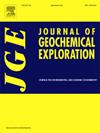成矿条件在胶状闪锌矿高锗富集中的作用——以半边街矿床为例
IF 3.3
2区 地球科学
Q1 GEOCHEMISTRY & GEOPHYSICS
引用次数: 0
摘要
胶体硫化物是中国南方重要的锗资源。半边街矿床位于中国西南部,是一个碳酸盐岩型锌锗矿床(0.8 Mt. @ 1.78 ~ 9.50% Zn和>;800 t @ 100-110 ppm Ge),富含胶状闪锌矿,富Ge纳米颗粒广泛存在。前人的研究表明,闪锌矿中Ge富集可能与内部机制有关,但对来源和流体混合等外部因素对Ge富集的影响知之甚少。在本研究中,我们应用原位微量元素和S-Pb同位素组成来解释影响Ge分布的外部控制因素。新的激光烧蚀电感耦合质谱(LA-ICP-MS)分析表明,闪锌矿的Ge含量在221 ~ 1916 ppm(平均为843 ppm)之间,与Fe、Mn、Pb浓度呈正相关,与Cd浓度呈负相关。硫同位素组成推断出一个主要硫源(~−10‰)和一个次要硫源(~−1‰)。闪锌矿的铅同位素比值在上地壳曲线上显示,表明其金属来源为地壳。硫同位素地温计估计闪锌矿的形成温度主要在250℃以下,pH值的变化可能引起硫化物相的转变。微量元素和δ34S值表明,富ge流体为主,富cd流体次之。富镉流体的流入与闪锌矿局部贫锗分带有关。我们认为流体混合可以局部影响闪锌矿中Ge的含量。本文章由计算机程序翻译,如有差异,请以英文原文为准。
The role of ore-forming conditions in high germanium enrichment of colloform sphalerite: A case study of the Banbianjie deposit, SW China
Colloform sulfides host significant germanium (Ge) resources in South China. The Banbianjie deposit, situated in southwest China, is a carbonate-hosted Zn-Ge deposit (0.8 Mt. @ 1.78 to 9.50 % Zn and > 800 t @ 100–110 ppm Ge) and is rich in colloform sphalerite with widespread occurrence of Ge-rich nanoparticles. Previous studies documented that Ge enrichment in sphalerite may be correlated to internal mechanisms, however, the impact of external factors, such as source and fluid mixing, on Ge enrichment is poorly understood. In this study, we applied in situ trace elements and S-Pb isotopic compositions to interpret the external controls influencing Ge distribution. New laser-ablation inductively coupled mass spectroscopy (LA-ICP-MS) analyses reveal that sphalerite contains very heterogeneous Ge contents from 221 to 1916 ppm (mean = 843 ppm Ge), positively correlating with Fe, Mn, and Pb and negatively with Cd concentrations. Sulfur isotopic compositions infer a predominant sulfur source (~ − 10 ‰) and a subordinate sulfur source (~ − 1 ‰). The Pb isotopic ratios of sphalerite plot on the upper crust curve, indicating a crustal source for the metals. The sulfur isotope geothermometer estimates the formation temperatures of sphalerite mainly below 250 °C and pH changes may cause the transition of sulfide phases. Trace elements and δ34S values indicate a predominant Ge-rich fluid and a subordinate Cd-rich fluid. The influxes of Cd-rich fluid are correlated with local Ge-poor zonings in sphalerite. We propose that fluid mixing can locally influence the Ge contents in sphalerite.
求助全文
通过发布文献求助,成功后即可免费获取论文全文。
去求助
来源期刊

Journal of Geochemical Exploration
地学-地球化学与地球物理
CiteScore
7.40
自引率
7.70%
发文量
148
审稿时长
8.1 months
期刊介绍:
Journal of Geochemical Exploration is mostly dedicated to publication of original studies in exploration and environmental geochemistry and related topics.
Contributions considered of prevalent interest for the journal include researches based on the application of innovative methods to:
define the genesis and the evolution of mineral deposits including transfer of elements in large-scale mineralized areas.
analyze complex systems at the boundaries between bio-geochemistry, metal transport and mineral accumulation.
evaluate effects of historical mining activities on the surface environment.
trace pollutant sources and define their fate and transport models in the near-surface and surface environments involving solid, fluid and aerial matrices.
assess and quantify natural and technogenic radioactivity in the environment.
determine geochemical anomalies and set baseline reference values using compositional data analysis, multivariate statistics and geo-spatial analysis.
assess the impacts of anthropogenic contamination on ecosystems and human health at local and regional scale to prioritize and classify risks through deterministic and stochastic approaches.
Papers dedicated to the presentation of newly developed methods in analytical geochemistry to be applied in the field or in laboratory are also within the topics of interest for the journal.
 求助内容:
求助内容: 应助结果提醒方式:
应助结果提醒方式:


